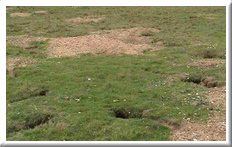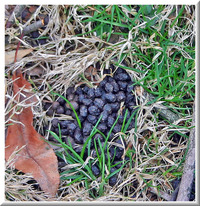 Once again the rabbit population along the Front Range is extremely high. Several factors, including the decrease in foxes and other natural predators, coupled with the extra precipitation of the spring, have contributed to this.When food sources are abundant the populations of rabbits per litter goes up. On average, rabbits have between 2 and 6 litters per year, each with up to 6 babies (the proper term for a baby rabbit is a kit, multiple babies are therefore called kittens). Over this past year the numbers of litters and kittens per litter have been toward the higher end of that range.
Once again the rabbit population along the Front Range is extremely high. Several factors, including the decrease in foxes and other natural predators, coupled with the extra precipitation of the spring, have contributed to this.When food sources are abundant the populations of rabbits per litter goes up. On average, rabbits have between 2 and 6 litters per year, each with up to 6 babies (the proper term for a baby rabbit is a kit, multiple babies are therefore called kittens). Over this past year the numbers of litters and kittens per litter have been toward the higher end of that range.
 Rabbits can do a great deal of damage to lawns. With high populations and the inability of grass to grow during the winter, they can cause serious problems for the lawn in spring. These damaging rodents normally spend their entire life in an area of less than ten acres, so once they become established in a lawn, they are unlikely to move without a good reason.The damage they can create can lead to big problems for yards and even shrubs. They not only chew grass down to the root, but the concentration of urine frequently creates brown and dying areas, making it harder for the grass to recover. When grass is dormant in winter, there is no chance for a recovery – meaning the rabbits’ feeding and excretions can kill areas of the lawn. Once this damage starts it tends to progress because rabbits like to feed in the same areas, and will even lead their kittens through their scent to those same areas.
Rabbits can do a great deal of damage to lawns. With high populations and the inability of grass to grow during the winter, they can cause serious problems for the lawn in spring. These damaging rodents normally spend their entire life in an area of less than ten acres, so once they become established in a lawn, they are unlikely to move without a good reason.The damage they can create can lead to big problems for yards and even shrubs. They not only chew grass down to the root, but the concentration of urine frequently creates brown and dying areas, making it harder for the grass to recover. When grass is dormant in winter, there is no chance for a recovery – meaning the rabbits’ feeding and excretions can kill areas of the lawn. Once this damage starts it tends to progress because rabbits like to feed in the same areas, and will even lead their kittens through their scent to those same areas.If areas of the lawn are showing damage, the best thing to do is to make the rabbits not want to come back. Then, once they are off the property, fencing off the area can keep them out. If damage can be stopped early before urine or stress kills the entire area, it can be reversed. Rabbits don’t eat the root system. This means the lawn has a great chance of coming back.
Although difficult, it’s not impossible to get rid of established rabbit families. They love low-to-the-ground shrubs as well as taller grass, because it provides them with shelter and extra food. Eliminate areas they could hide. Trimming shrubs and bushes, putting chicken wire below porches so they can’t get under areas where they can build dens, and elevating any kind of decorative garden pieces where they could hide are all good countermeasures.
Another way to get the annoying rodents to seek a new location is to cut off their food supply. Put perimeter fences around, making sure that the openings of the fence are smaller than a rabbit’s head and dug 6 inches into the ground so they can’t sneak through underneath.
Spraying/sprinkling different natural odors on your plants like capsaicin (pepper extract), castor oil, ammonium salts, or predator urine can also help, but they must be reapplied after every watering or rain.
Another good option is to let household pets out onto the lawn areas in the early mornings and late evenings when the rabbits are most active. If rabbits are constantly getting chased by something they deem as a predator, they will be much less likely to stay in the area and it will discourage them from breeding in those areas.


